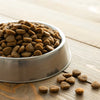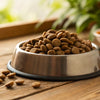Understanding Why Won't My Dog Eat His Dry Food: A Comprehensive Guide
- Houndsy
Table of Contents
- Introduction
- Understanding Your Dog's Eating Habits
- Practical Solutions to Encourage Eating
- When to Consult a Veterinarian
- Final Thoughts
Introduction
Have you ever found yourself staring at your dog's untouched bowl of dry kibble, an unsettling feeling of worry creeping in? You're not alone. According to a study published in the Journal of Animal Science, about 15% of dog owners report that their pets occasionally refuse to eat their regular dry food. This behavior can be concerning, leaving us as pet parents wondering, "Why won't my dog eat his dry food?"
The feeding ritual is a vital part of our dogs’ daily lives, and when they skip meals, it can signal deeper issues, whether they are physiological, psychological, or simply a matter of taste. In this blog post, we will explore the myriad reasons behind your dog’s refusal to eat dry food, practical solutions to encourage a healthier eating habit, and when it’s essential to consult a veterinarian.
By the end, you will have a clearer understanding of your dog's dietary preferences and how to enhance the feeding experience—not just for them, but for you as well. So, let’s dive in, and as we do, reflect on your own dog’s feeding routine. Is there a consistent pattern, or has something changed recently?
Understanding Your Dog's Eating Habits
The Importance of a Balanced Diet
Just like us, dogs thrive on routine and balance. A dog's diet typically consists of proteins, carbohydrates, fats, vitamins, and minerals. Dry dog food, or kibble, is designed to meet these nutritional needs. However, there are circumstances that can disrupt this balance, causing our furry friends to turn their noses up at their meals.
Common Reasons Dogs Refuse Dry Food
-
Health Issues:
- Dental Problems: Pain from dental issues like gum disease or broken teeth can make chewing kibble uncomfortable. If your dog suddenly stops eating dry food but seems to prefer softer options, it may be due to oral discomfort.
- Gastrointestinal Issues: Dogs can experience upset stomachs due to various reasons—from dietary indiscretions to more serious conditions like pancreatitis. If your dog seems lethargic or is experiencing vomiting or diarrhea alongside their refusal to eat, a vet visit is warranted.
-
Behavioral Factors:
- Stress and Anxiety: Changes in environment or routine can lead to anxiety that affects appetite. A dog may refuse to eat during stressful situations like moving to a new house, the introduction of a new family member, or even during thunderstorms.
- Picky Eating: Some dogs are simply more discerning when it comes to their food. If they learn that refusing kibble results in tastier treats, they may hold out for something better.
-
Food-Related Issues:
- Kibble Fatigue: Just like us, dogs can grow tired of the same flavor or texture. If they’ve been eating the same kibble for an extended period, they may start to lose interest.
- Expiration and Quality: Dry food can go stale or spoil, especially if not stored properly. Always check the expiration date and ensure the kibble is kept in a cool, dry place.
Practical Solutions to Encourage Eating
Enhancing the Meal Experience
-
Switch Up the Kibble:
- If your dog is experiencing kibble fatigue, try rotating different flavors or brands to spark their interest. This can make mealtime more exciting.
-
Make It More Appetizing:
- Adding a little warm water or low-sodium chicken broth to dry kibble can enhance the aroma and flavor, making it more enticing. Just be sure to stir well to avoid hot spots.
-
Incorporate Tasty Toppers:
- Consider adding dog-safe toppers like plain yogurt, pumpkin puree, or even small pieces of cooked chicken. These additions can increase palatability without compromising nutritional balance.
-
Use Puzzle Feeders:
- Dogs are naturally curious and love to engage their minds. Puzzle feeders can turn mealtime into a stimulating activity, encouraging your dog to eat more eagerly.
-
Hydration Matters:
- Ensure your dog is drinking enough water. Dehydration can impact appetite. If your dog seems reluctant to drink, try adding ice cubes or offering flavored water with a splash of low-sodium broth.
Modifying Feeding Habits
-
Establish a Routine:
- Dogs thrive on routine. Feeding your dog at the same time each day can help create anticipation for their meals. If they don’t eat within 15–20 minutes, remove the food and try again during the next scheduled meal time.
-
Create a Comfortable Eating Environment:
- Make sure their feeding area is quiet and free from distractions. Some dogs prefer elevated bowls or mats that provide stability while they eat.
-
Hand-Feeding:
- Sometimes, hand-feeding can encourage a dog to eat, especially if they’re feeling anxious or unsure about their food.
When to Consult a Veterinarian
If your dog refuses to eat for more than 24 hours, or if you notice additional symptoms like vomiting, diarrhea, or lethargy, it’s essential to consult a veterinarian. Sudden changes in appetite can be a sign of underlying health issues that require attention.
Recognizing Serious Health Conditions
- Chronic Illnesses: Conditions such as diabetes, kidney disease, or cancer can lead to changes in appetite. Regular check-ups can help catch these issues early.
- Pain and Discomfort: If your dog shows signs of pain while eating or appears to be uncomfortable, such as whining or avoiding the feeding area, it’s crucial to seek veterinary advice.
- Behavioral Changes: Any significant shift in your dog’s behavior, including eating habits, warrants a professional evaluation. This could indicate anxiety, depression, or other behavioral issues that may need addressing.
Final Thoughts
Understanding why our dogs refuse to eat dry food can be a complex puzzle. By considering the reasons behind this behavior, we can find effective solutions to encourage healthy eating habits. Remember, a balanced diet is crucial for our furry friends, and their mealtime experience should be enjoyable and stress-free.
As we navigate the feeding landscape, it’s important to keep our dogs’ preferences and health in mind. If you’re looking to simplify and elevate your dog-feeding experience, we invite you to explore our Houndsy Kibble Dispenser. Designed with both form and function in mind, it allows for convenient portion control and complements your home decor beautifully. Check it out here!
FAQ
Q: What should I do if my dog refuses to eat dry food? A: Start by evaluating their health and environment, then try enhancing the food’s flavor or switching to a new brand. If they continue to refuse food for over 24 hours or show other symptoms, consult your vet.
Q: Can stress cause my dog to stop eating? A: Yes, stress from changes in their environment or routine can lead to a decreased appetite in dogs.
Q: How can I make my dog's dry food more appealing? A: Adding warm water, low-sodium broth, or dog-safe toppers can enhance flavor and aroma, making dry food more enticing.
Q: How long can a dog go without eating before it becomes serious? A: If your dog refuses to eat for more than 24 hours, or if they show signs of illness, it’s important to seek veterinary advice.
Q: Is it okay to switch my dog's food frequently? A: While variety can help keep your dog interested, sudden changes can upset their stomach. Gradually introduce new food over a week to avoid digestive issues.
By understanding and addressing the reasons behind your dog's refusal to eat dry food, we can create a positive feeding environment that promotes their health and happiness. Embrace the journey, and your dog's mealtime will transform into a delightful ritual that you both look forward to!












